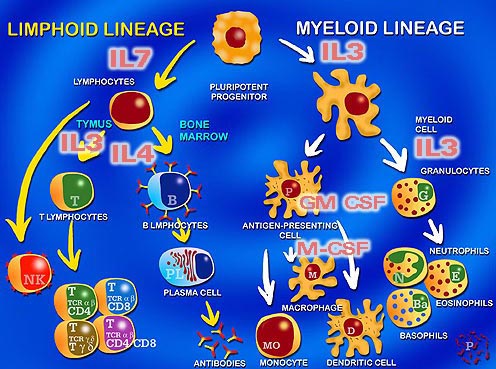Cytokines Therapy is the Fastest Grown Direction in Modern Medicine
Cytokines Therapy /cy·to·kine/ (si´to-kīn″) a common term for non-antibody proteins released by one cell population on interaction with particular antigen, which work as intercellular mediators, as in the peers of an immune reaction.
Another word cytokines are one of a large collection of low-molecular-weight proteins created by various cell groups and involved in cell-to-cell communication, managing antibody, and T cell immune exchanges, and intensifying immune reactivity. Cytokines contain colony-stimulating factors, interferons, interleukins, and Lymphokines, which are synthesized by lymphocytes.
Cytokines Therapy are a unique group of non-antibody proteins that perform as messengers between cells.
They were originally recognized as products of immune cells that act as mediators and controllers of immune developments but numerous cytokines are now identified to be created by cells other than immune cells and they can have effects on non-immune cells as well. Cytokines are currently being used clinically as biotic reaction transformers for the treatment of various conditions. The term cytokine is a broad-spectrum term used to define a large group of proteins but there are other terms that are frequently used to outline specific varieties of cytokines.
The following chemical factors create the generic meaning of cytokines:
• Monokines – produced by mononuclear phagocytic cells
• Lymphokines – produced by activated lymphocytes, especially Th cells
• Interleukins – that act as mediators between leukocytes
Cytokines Therapy are not normally kept as preformed proteins.
Rather their production is originated by gene record and their mRNAs are short lived. They are formed as required in immune reactions. Many specific cytokines are manufactured by various cell categories and act on various cell kinds (i.e., they are pleiotropic) and in a lot of circumstances, cytokines have parallel actions (i.e., they are redundant). Redundancy is due to the nature of the cytokines’ receptors. Receptors for cytokines are heterodimers (sometimes heterotrimers) that can be clustered into groups in which one subunit is mutual to all members of a specified family. Some illustrations are displayed in Figure 1. Since the subunit similar to all members of the family functions in binding cytokine and in signal transduction, a receptor for one cytokine can often respond to another cytokine in the same family. Thus, an individual lacking IL-2, for example, is not adversely affected because other cytokines (IL-15, IL-7, IL-9, etc.) assume its function. Similarly, a mutation in a cytokine receptor subunit other than the one in common often has little effect. On the other hand, a mutation in the common subunit has profound effects. For example, a mutation in the gene for the IL-2R gamma subunit causes human X-linked severe combined immunodeficiency (XSCID) characterized by a complete or nearly complete T and B cell defects.
One cytokine often influences the synthesis of other cytokines. They can produce cascades, or enhance or suppress production of other cytokines. In addition, they can often influence the action of other cytokines.
The effects of different cytokines can be:
• Antagonistic
• Additive
• Synergistic
Cytokines bind to specific receptors on target cells with high affinity and the cells that respond to a cytokine is either:
1) the same cell that secreted them (autocrine);
2) a nearby cell (paracrine) or
3) a distant cell reached through the circulation (endocrine). Cellular responses to cytokines are generally slow (hours) because they require new mRNA and protein synthesis.
Many cytokines are very useful therapeutic targets in disease
The pitch of cytokines era came of age in the dawn 1970s with the invention of molecular biological methodologies that resulted first in the cloning of IFNs, initially IFN-β by Tada Taniguchi and IFN-α by both Charles Weissman’s group and David Goeddel’s colleagues. By the mid-1980s, there were a plethora of well-defined cytokines and cytokine receptors that could be explicitly considered, using molecular tools, such as cDNA probes, and antibodies that had been produced to recognize the pure recombinant proteins. All this was a long way from the 1960s and 1970s when all scientists had been many uncharacterized bioactivities in cell supernatants termed simply by activity, e.g., lymphocyte-activating factor, macrophage-activating factor, and leukocyte pyrogen.
All the tools available by the mid-1980s enabled researchers to assess the expression of cytokines in physiologic and pathologic states. The unregulated expression of cytokines in many different disease states led to an investigation of their role in the pathogenesis of the disease, and the articles in this Review Series barely scratch the surface of the plethora of information now available. As cytokines are potent rate-limiting extracellular molecules, they are excellent targets for the products of the biotechnology industry, namely monoclonal antibodies, and antibody-like receptor: Fc fusion proteins. These form the most specific therapeutics, more specific than small molecule organic chemicals, due to the larger surface of communication of receptors and antibodies with their targets.
At Viva Healthy Life, Victor Tsan MD uses Italian made cytokines for clinical purposes treating a variety of disorders.
Dr. Tsan applies Cytokine Therapy ordering oral formulas tailored to specific patients’ problems from Italian Pharmaceutical Company GUNA S.P.A and within literally a few days patient’s condition improves.
CYTOKINES THERAPY USES SIGNALING MOLECULES IN CLINICAL PRACTICE FOR THE REPAIR OF DAMAGED TISSUES AND TO INDUCE HEALING IN MOST

You must be logged in to post a comment.